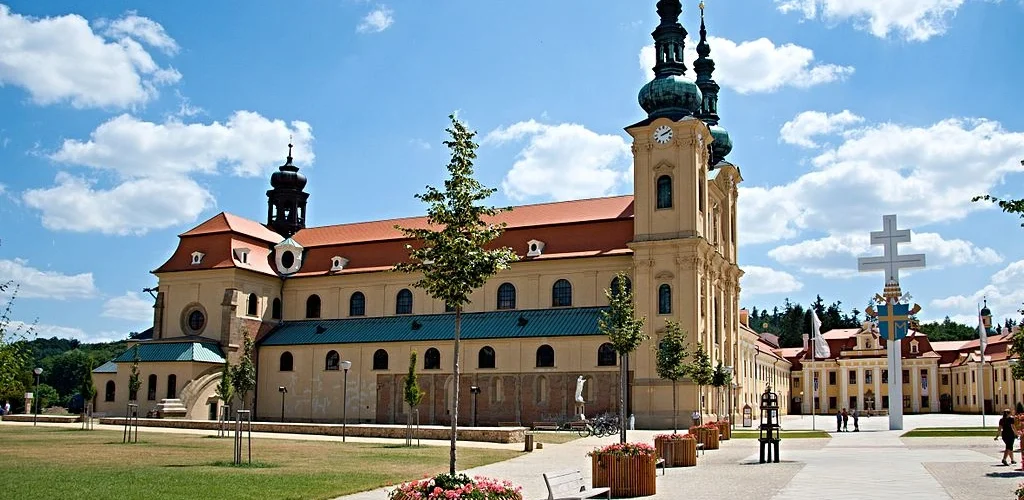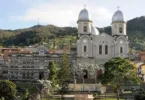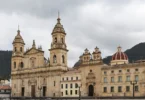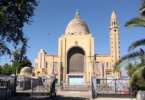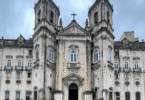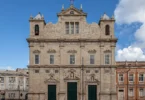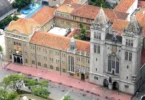Introduction
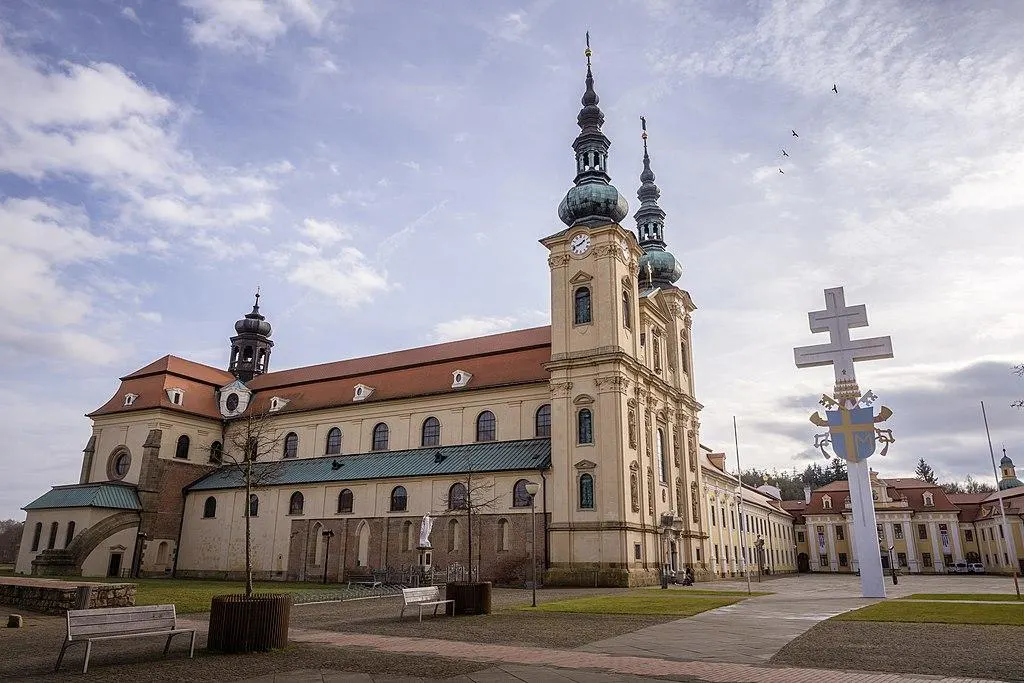
The Basilica of the Assumption of the Virgin Mary and Saints Cyril and Methodius is part of the Velehrad Monastery. It’s one of the most important pilgrimage sites in the Czech Republic and also serves as the local parish church in Velehrad. In 2008, it was officially named a national cultural monument. The basilica is open to the public all year round, and anyone can visit.
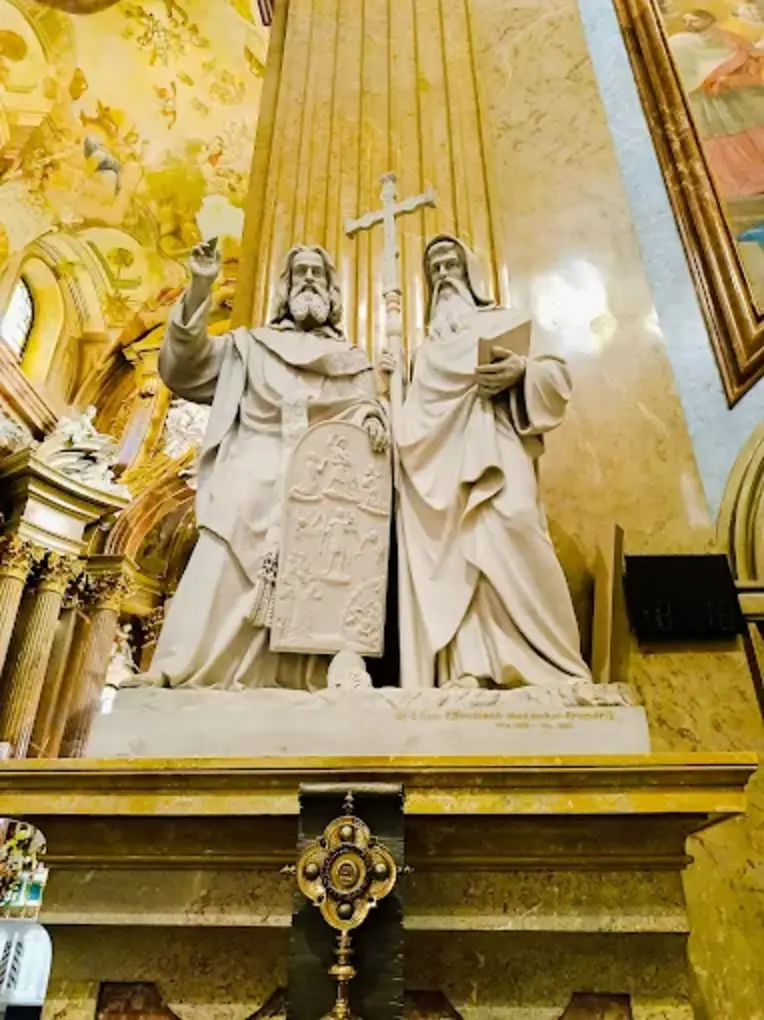
The Velehrad monastery was founded thanks to Bishop Robert of Olomouc (who was bishop from 1201 to 1240) and the Moravian Margrave Vladislav Jindřich. They built it near the village of Velehrad, which is now called Staré Město u Uherské Hradiště. The monastery church, dedicated to the Assumption of the Virgin Mary, was blessed by Bishop Robert at the very start of its construction on November 27, 1228. King Přemysl Otakar I was also there at the ceremony. Back then, only the eastern part of the church probably the presbytery and transept was finished. Some of the nearby monastery buildings were likely done too. The plan was for Velehrad to be the burial place for the Moravian branch of the Přemyslid family. But in January 1421, Moravian Hussites took over the monastery, and the church fell into bad shape for more than a hundred years. It wasn’t until Abbot Jan Greifenfels of Pilsenburg’s time, between 1629 and 1639, that the church was restored and rebuilt in the Baroque style.
After a fire in 1681, the monastery took on its current appearance at the turn of the 17th and 18th centuries. The monastery church was repaired by abbots Bernard Kapárek, Florián Nezorin, and Josef Mal, who succeeded Abbot Petr Silaveck. No one knows exactly who designed the Baroque makeover, but many think Giovanni Pietro Tencalla, a famous architect of the time, had a big influence. Some notable artists worked on the inside: Ondřej Ollio, a stonemason and marble worker; sculptor Michael Mandík; and painters Paolo Pagani and Michael Leopold Willmann. During the renovations, the church got a bit shorter the vestibule and the western facade were taken down by about 14 meters. This included the removal of the old Romanesque entrance. The new facade got two towers, and a dome with a small lantern was added above the nave’s transept. Even after all these changes, the church still kept its Romanesque-Gothic feel. Inside, thick brick walls replaced the old rows of pillars on the western side, dividing the side aisles into 14 chapels. Ten of these chapels had altars and crypts underneath. Over time, the ground outside rose by about two meters, so the church floor was raised too. The nave and crossing were filled in with rubble to support the structure.
After another fire in 1719, Abbot Josef Malý took on the tough job of finishing the work. In 1724, the church’s interior was decorated by Baldassare Fontana, an Italian sculptor and stucco artist. Other artists like marble worker Jan Hagmüller and painters Jan Jiří Etgens, František Řehoř, and Ignác Eckstein contributed, with Eckstein painting frescoes in the main nave. The last abbot, Filip Zuri, invited painter Ignác Raab, who created many of the large altarpieces. The church was reconsecrated on October 2, 1735. Later, the monastery was shut down during Emperor Joseph II’s Enlightenment reforms. From 1784 on, the church served as a parish church for the local people. Natural disasters, like a hailstorm in 1828, and money problems meant the church wasn’t well maintained. Things got a bit better between 1863 and 1885, especially with the start of annual celebrations marking Cyril and Methodius’s arrival in Great Moravia. In 1890, the Jesuits came to the monastery and helped grow its importance as a pilgrimage site. Then, in 1928, Pope Pius XI gave the church the title of minor papal basilica, highlighting the importance of Saints Cyril and Methodius. A few years later, in 1932, the church’s name was officially expanded to include the two saints. The basilica underwent extensive renovations over the following decades, including explorations of its underground spaces. After 1950, the communist government tried to shut down all religious activities here. The monastery was closed, monks were forced out, and pilgrimages were limited. But in 1969, the local parish administrator, Rudolf Vašíček, raised money from believers to start fixing the basilica’s roofs, with many volunteers helping out.
Later Years and Recognition
In 1985, Pope John Paul II honored the basilica with the Golden Rose, a special award. This took place during a large pilgrimage to commemorate the one hundred years since St. Methodius’s death, which drew nearly a quarter of a million people. After the Velvet Revolution, spiritual life slowly came back to Velehrad, helped by Pope John Paul II’s visit in 1990. The monastery buildings and the basilica itself needed serious repairs because they had fallen apart over time. Between 2005 and 2009, the towers and roofs were fixed, and the chancel and underground areas were restored. In 2008, the basilica and the old monastery buildings were officially named a national cultural monument of the Czech Republic. Between 2010 and 2013, the whole monastery complex was fully renovated to prepare for the 1150th anniversary of Saints Cyril and Methodius arriving in Great Moravia. This included work on the basilica and a fresh architectural look for the surrounding area. Most of this was paid for through European Union funds.
Architecture of Basilica of Assumption of Mary and Saint Cyrillus and Methodius, Velehrad, Czechia
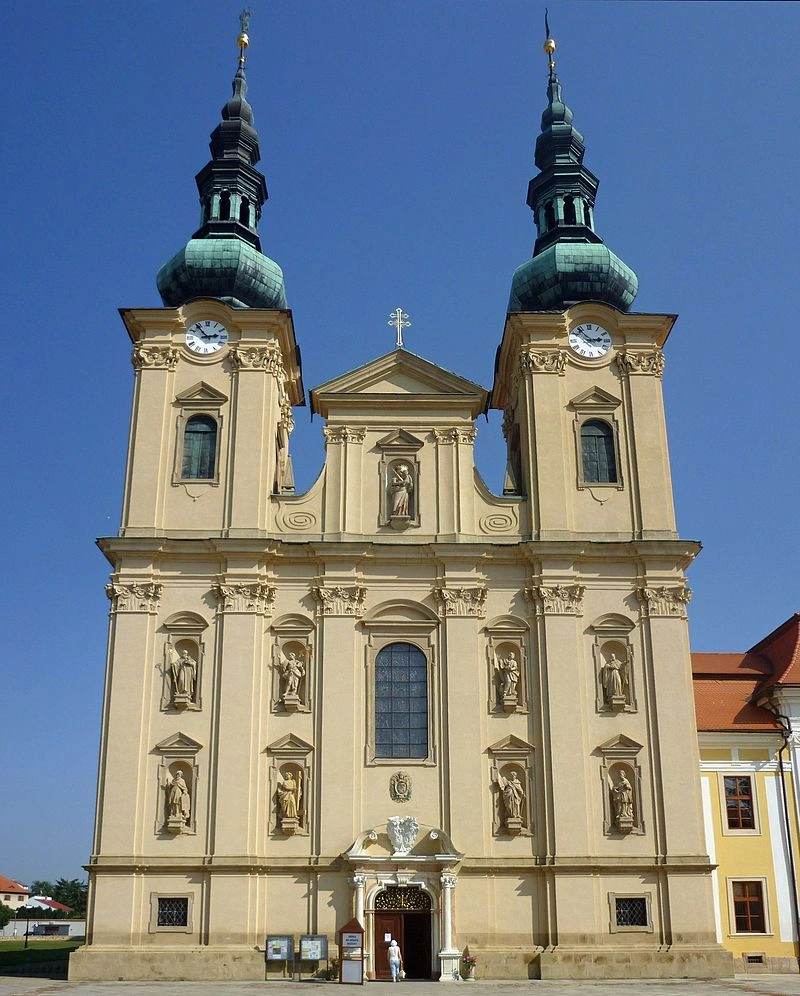
Architect: Giovanni Pietro Tencalla
Architectural style: Romanesque architecture
Burials: Antonín Cyril Stojan
Exterior of the Basilica
The basilica is a long, narrow building about 86 meters in length. It has a single main hall with a cross-shaped section near the middle, called a transept. At the back, there’s a rounded part called an apse, actually made up of three smaller rounded sections attached to the main space and side chapels. The front of the building faces the main courtyard and is marked by two tall, square towers. On the ground floor, a series of small chapels with distinctively sloping roofs line the sides of the main hall. These chapels break up the long walls, so they don’t feel overwhelming. Right above the place where the main hall crosses the transept, there’s a dome with a slender turret topped by a little lantern called a sanctus. On the north side of the transept, there’s a round Romanesque-style window and two large buttresses that help support the walls. The front façade is divided by flat, vertical columns called pilasters and has eight niches, each with a statue of a saint. The statues you see today are copies; the originals were moved inside the monastery’s cloister for safekeeping. They were made back in 1898 by a local sculptor named Ferdinand Neumann. A statue of the Virgin Mary holding the infant Jesus can be found in the decorative gable just above the main entrance. Above her, a triangular pediment shows a special cross symbol connected to Saints Cyril and Methodius. The two towers reach about 68 meters high. The bell tower has clock faces and is topped with an onion-shaped roof, which continues upward into an open, eight-sided lantern finished with a decorative finial and banner. Right above the church door, you can see the coat of arms of Pope Pius XI, honoring the pope who gave the church special status. Below that are the heraldic symbols of the monastery’s founders: the eagle representing the Moravian Margrave Vladislav Jindřich, and the lion for King Přemysl Otakar I.
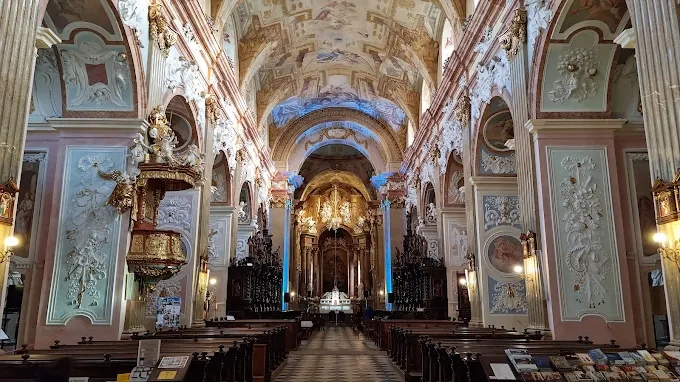
Interior of the Basilica
Main Nave
Large semicircular windows high in the vault make the main nave inside bright and airy.These windows let in plenty of light and make the church feel much taller than it actually is. The ceiling is a beautiful Baroque barrel vault with lunettes small windows set into arches along the vault. The artwork on the vault was painted by Ignaz Eckstein and is designed to extend the sense of height by adding the illusion of three extra floors. Near the triumphal arch that separates the nave from the presbytery, there’s a fresco dating from 1722. It shows the destruction of the monastery by the Hussites in 1421 and the tragic burning of the abbot and several monks on the altar steps. Closer to the main entrance, another part of the fresco shows the sky with the Holy Trinity and the Virgin Mary acting as a mediator of grace. Another section depicts the baptism of the Moravian King Svatopluk, which, according to tradition, was performed by Saints Cyril and Methodius. There are 14 side chapels, each with a brick altar, along the sides of the nave. The chapels are dedicated to various saints connected to the church’s history and patrons.
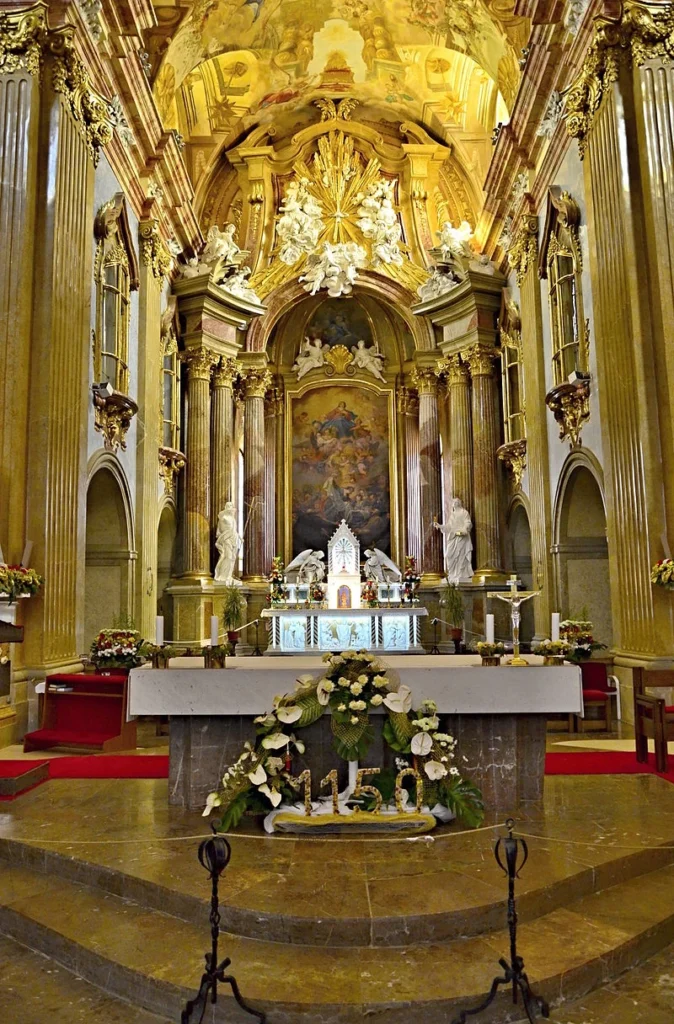
Presbytery
The presbytery, or the front part of the church where the altar stands, has a columned design created by the sculptor and architect Baldassare Fontana. Sculptures of St. John the Baptist and St. John the Evangelist stand here as well. The main altarpiece shows the Assumption of the Blessed Virgin Mary and dates back to the 1770s, painted by Ignác Raab. The original Baroque altar was taken away in 1864 and replaced by a white marble altar donated by Cardinal Bedřich of Fürstenberg, the Archbishop of Olomouc. This altar is richly decorated with Venetian mosaic panels and porphyry slabs. It also features two angels in adoration and a group of reliefs beneath the altar table with scenes tied to Saints Cyril and Methodius such as the death of St. Methodius, the farewell of the brothers in Rome before Cyril’s death, and St. Methodius receiving the archbishop’s pallium from Pope Hadrian II. Flanking these scenes are statues of St. St. Wenceslas and Ludmila. All these reliefs were created by the sculptor Carl Johann Steinhaüser.Cardinal Tomá pidlk’s ashes are housed in a marble sarcophagus behind the altar. Around it is a band of eight miniature biblical scenes representing key moments from his life, with a mosaic wall behind bearing inscriptions about his life’s meaning and work. The altar table itself was made in 1985 by architect Tomáš Černoušek and sculptor Otmar Oliva, both from Velehrad. Near the dome’s supporting pillars on either side are two sculptural groups: St. Peter and Paul on the left, and St. Cyril and Methodius on the right. These were made by Ferdinand Neumann in the early 1900s.
Transept Chapels
On either side of the transept, two chapels were built during the Baroque reconstruction, dedicated to St. Benedict on the left and St. Bernard on the right. Fontana also designed the Baroque altars here. The altarpieces show scenes from the saints’ lives. St. Peter’s church chapel Benedict, the painting was based on a work by Michael Willmann, and there are sculptures of St. Benedict and his sister St. Scholastica. A glass coffin with relics of St. Illuminatus was placed on the altar in the 19th century. The church of Saint Bernard contains a similar reliquary with the remains of St. Victor. Sculptures of St. Bernard and his sister St. Humbelina stand here, though their artist remains unknown.
Sacristies and Additional Chapels
Two sacristies were constructed during the Baroque era in the space that was once home to choir chapels in the Romanesque presbytery. Even today, the right sacristy, also known as the summer sacristy, is utilized. New chapels designed by architect Klaudius Madlmayr were built between the sacristies and the main altar between 1935 and 1938. These chapels contain wooden statues of St. Ignatius and the Divine Heart, crafted by the workshop of Viktor Kotrba.
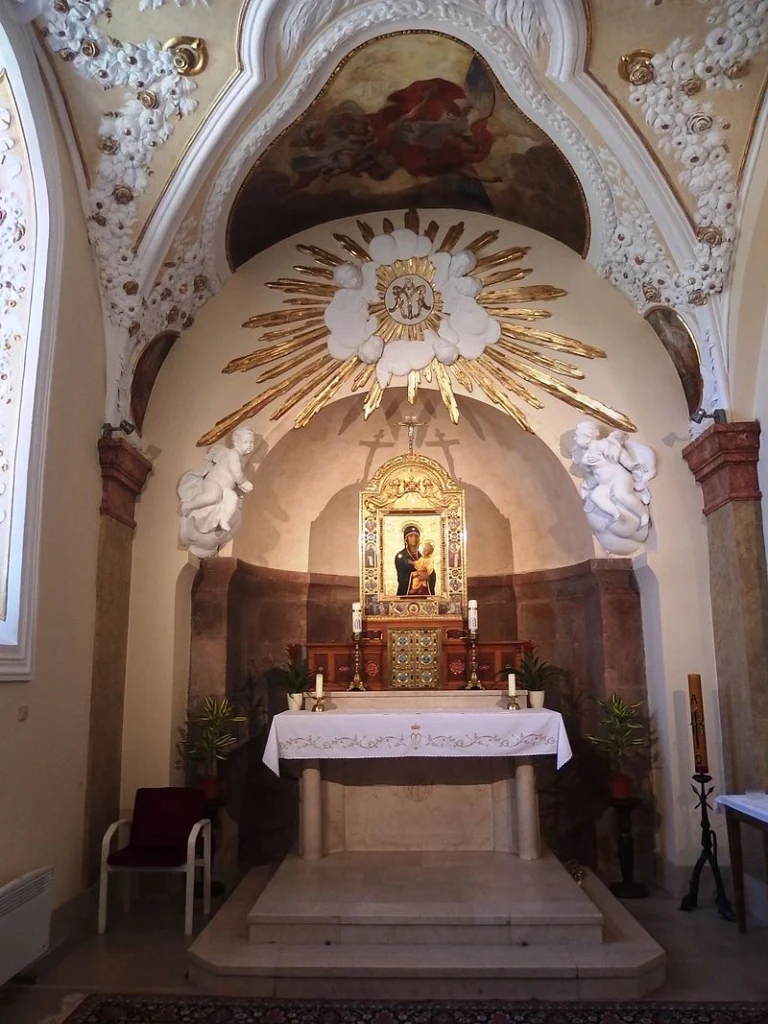
Chapel of the Mother of Christian Unity
Originally, this space was the winter sacristy when the monastery was active, and later it became the Chapel of St. Joseph. In the 1930s, it was redesigned into its current form. The marble altar here, designed by K. Madlmayr, follows an early Christian style. An image of the Virgin Mary and the Infant Jesus, known as a palladium, hangs above the tabernacle, which is made of wrought brass with gold plating. This was created in 1919 by Emanuel Dítě and is based on a Byzantine icon from the Basilica of Our Lady the Greater in Rome. Two angels adorn a crown that contains a relic of Christ’s crown of thorns in the gilded bronze frame around the image. The frame also includes small paintings of Czech patron saints holding relics. In the lower corners, you can see depictions of the arrival of Saints Cyril and Methodius to Moravia, and the moment Pope Hadrian II gave them the pallium. Beneath the icon is a relic of St. Josaphat. The frame is decorated with 46 semi-precious stones. On one wall, there’s a painting by František Ženíšek showing the death of St. Methodius; this painting was a study for a large lunette in the National Museum’s Pantheon. Giovanni Ciani made this marble baptismal font, which Olomouc theologians donated in 1885. The wooden dome overhead is decorated with images of saints, symbols of the four evangelists, and a statue of St. John the Baptist. The painting of St. The Polish artist W gave the Cyril and Methodius above the baptismal font as a gift. Hofmann in 1949. The stained glass windows in the chapel were created in 1939 by the firm Kunisch in Brno, following Madlmayr’s plans.
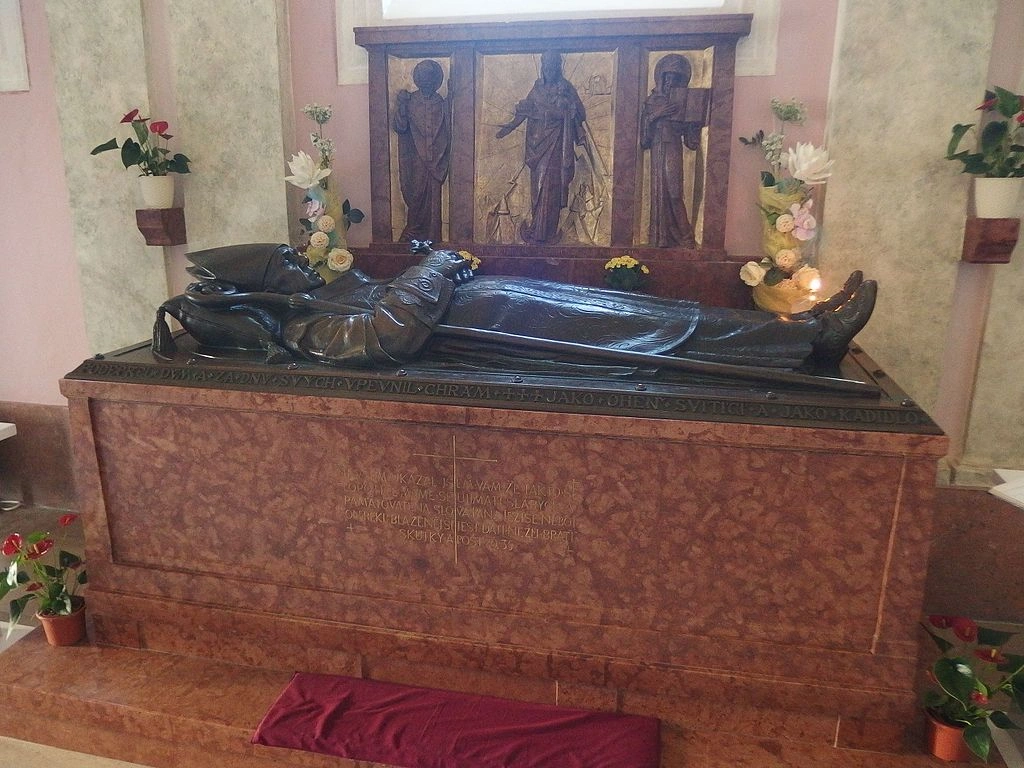
Royal Chapel
The Royal Chapel was added in 1965 to the north side of the transept. Its decoration honors the monastery’s founders and benefactors. There are three stained glass windows from 1939, showing important figures connected to the monastery. The Moravian Margrave Vladislav Jindřich, founder of the monastery, is buried here, marked by a bronze plaque made by Otmar Oliva for the 800th anniversary of his death. The chapel features coats of arms representing the monastery’s founders, important abbots, the Cistercian order, and the monastery itself. These were designed by Klaudius Madlmayr. The main focus of the chapel is the tomb of Archbishop Stojan, which includes a bronze relief created by Madlmayr and sculptor Julius Pelikán. The lower part is made of marble by the Axman workshop in Olomouc. Between the tomb and a central window is a marble relief of the Virgin Mary of St. Hostýn, flanked by figures of Saints Cyril and Methodius. The relief behind them shows the pilgrimage sites of St. Hostýn and Velehrad, two of Moravia’s most important religious places. This three-part relief was made by Otmar Oliva.
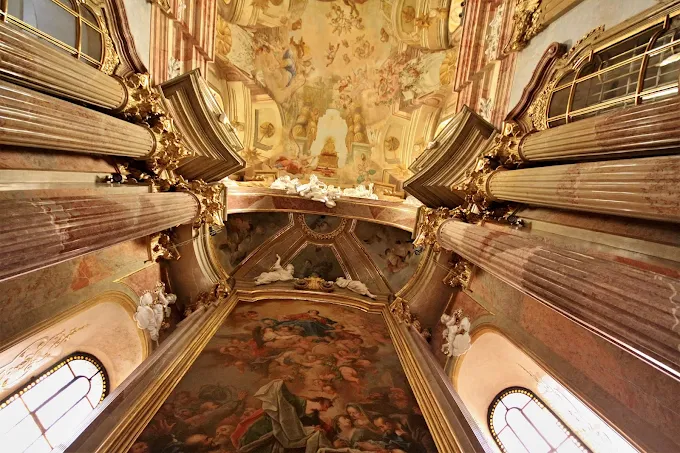
Dome
The church didn’t have those big towers from the start. Back in the day, there was just a small bell tower right above where the nave and the transept cross. In the 16th century, Abbot Ekard of Schwoben decided to build a massive tower here with three Renaissance domes stacked on top. But when they did the Baroque makeover, they took down the Renaissance tower and put in a Baroque dome in its place. This dome has a low lantern sitting above the roof. Inside, the whole dome is covered in murals featuring the monastery’s founders the Moravian Margrave Vladislav Jindřich and his brother, King Přemysl Otakar I. If you look up at the corners under the dome, called pendentives, you’ll see paintings of the church’s great teachers: St. Augustine, St. Ambrose, St. Jerome, and Gregory the Great. The vault of the dome is pretty tall, reaching 25 meters high.
Choir Benches
The ones we see today are only part of a larger ensemble from the turn of the 17th and 18th centuries. The benches for the abbot and prior , originally standing at the main altar, were removed and destroyed after the monastery was dissolved in 1784. The preserved benches are designed as two symmetrical opposing units, covering two arcades of Baroque side chapels, which for this reason do not have altars. It is the work of an unknown artist, but there is no doubt about its domestic origin, as evidenced in particular by the ornamental decoration, drawing inspiration from the domestic environment of fields, vineyards, gardens, meadows and forests. The date 1693, which was discovered on the back of the benches, was written by the carpenter’s apprentice Jan Martin Heyden from Litovl in 1695. The Baroque architecture of the benches bears 60 statues of saints and angels in the niches.
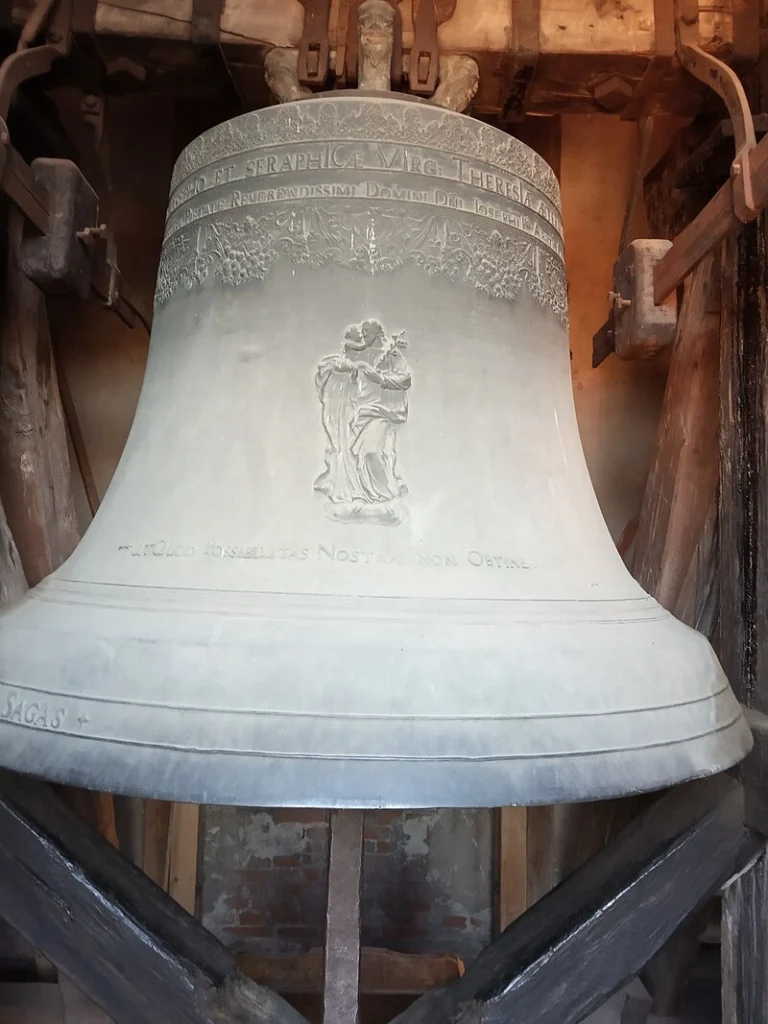
Bells
The basilica has six bells spread across three bell towers one tower for each set of bells. The biggest bell hangs alone in the front north tower, which is about 60 meters tall. It requires two bell ringers to swing it because it is huge and weighs 5.3 tons. Because it is heavy work, they must take turns with at least two other people. This big bell only rings for special celebrations. For example, in 2019, it rang just 18 times. The south tower has two bells that are rung by hand, while the small bell in the sanctus tower is electric. Most of these bells were cast in the early 1700s. All of them are looked after by Velehrad’s local bell ringers.
Pulpit
The pulpit is a masterpiece by Italian artists, probably led by B. Fontano, and was created prior to 1735. On top, the canopy shows a figure symbolizing the Church holding a cross, an anchor, and a chalice symbols of divine virtues. Around her, nine angels hold tablets of the Ten Commandments and the four Gospels, showing Christian faith and morals. Inside the canopy, there’s a golden wreath surrounding a dove, representing the Holy Spirit. On the front, the main relief shows Christ revealing himself to the apostle Thomas. There are three gilded reliefs on the sides of the pulpit basket: one of Peter being made head of the church, another of Christ at Jacob’s well, and another of Christ on the way to Emmaus.
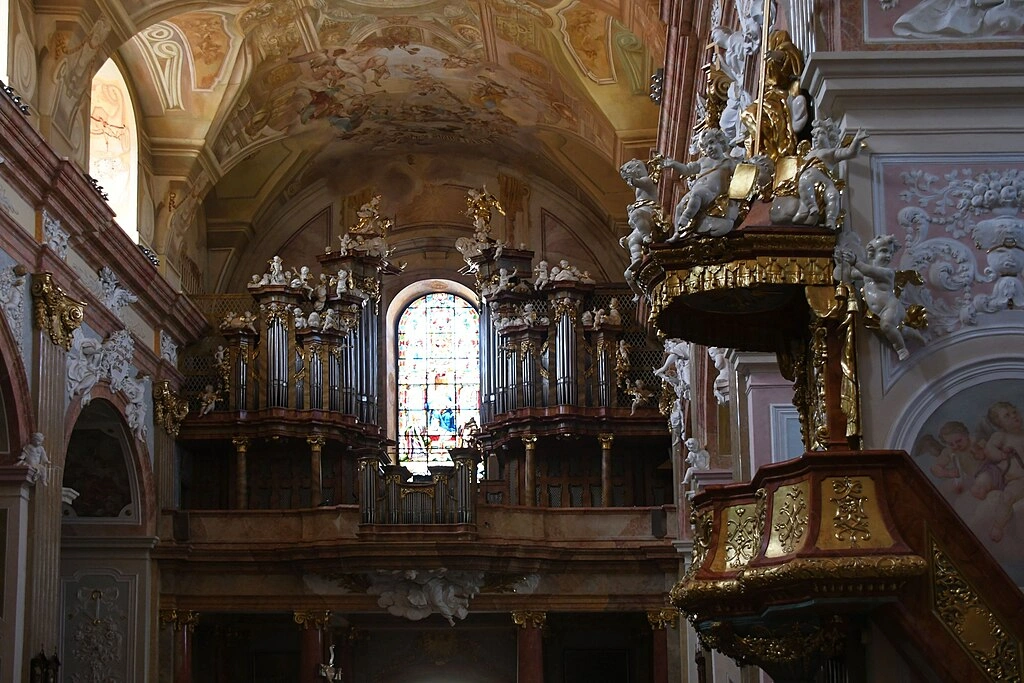
Choir Loft and Organ
Above the choir loft, you can see a fresco of St. Cecilia, the patron saint of church music, leading a heavenly choir. There’s also a stained glass window showing the Virgin Mary with Saints Cyril and Methodius. The organ you hear today was installed in the 1960s but kept the beautiful Baroque cases from the mid-1700s. The Rieger-Kloss factory built the new organ, which has 60 stops and more than 5,500 pipes! The cases are decorated with sculptures of angels singing and playing instruments. The most striking figure on the organ’s front is a scene of the Annunciation, where the angel Gabriel tells Mary she will have Jesus.
Side Chapels and Their Treasures
Only ten of the 14 Baroque chapels that line the sides of the basilica have altars dedicated to various saints, such as St. Wenceslas, St. Florian, Mary Magdalene, Mary of Egypt, Saints Cyril and Methodius, Catherine, Barbara, and also some honoring Cistercian saints and angel choirs. Each of these altars has a style that is related to B’s workshop. Fontana, and many of the wall paintings were done by local artists from Brno, such as F. Eckstein and JJ Etgens, occasionally focusing on P’s earlier works. Pagani. Large altar paintings by M. Willman and I. Raab can also be seen, with Raab occasionally repainting parts of Willman’s originals in the 1770s. St. Peter’s church chapel Wenceslas, the Polish artist Jan Matejko gave the Polish people a well-known painting of Saints Cyril and Methodius in 1885. Nearby, the chapel of St. Florian holds a wooden statue of St. Joseph carved by Štěpán Zálešák. The church of Saint Catherine features a banner embroidered in 1927 by Slovak women from Cífer, decorated with traditional Slovak folk motifs. The church of Saint Barbara contains two banners from 1885, donated by Polish pilgrims and Czechoslovak immigrants in the US. Beneath the music gallery hangs a large wooden cross made in 1860 by Augustin Sedláček, a self-taught artist. There are also two paintings by I. Raab portraying St. Bernard, inspired by a local legend about the monk Fortunatus. A painting of St. Peter is located near the entrances to the tower. Cyril and Methodius by A. Tchoová, and a 1949 portrait of Pope Pius XI by Jan Pojsl can be found on the opposite side.
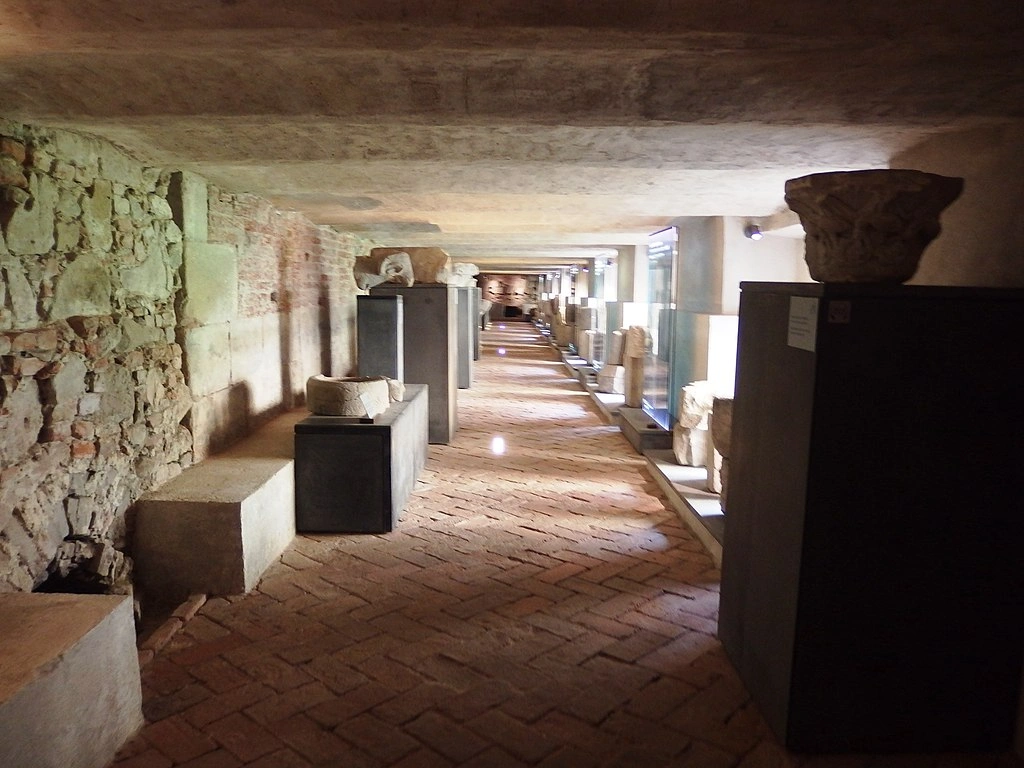
Underground Crypts
Beneath the basilica are crypts built in the late 1600s to support the new Baroque pillars. Originally, the small crypts were separate and connected to the church by special stairs. The crypts under the presbytery and transept chapels were later joined together. Monks and benefactors were buried there. By the mid-1700s, groundwater caused problems, so the crypts were sealed and forgotten for a long time. In the 20th century, they were reopened and connected, revealing parts of the old Romanesque front wall and portal. The whole underground space stretches about 400 meters. Down here, you’ll also find a lapidarium with original Romanesque and Gothic portals and other archaeological treasures. Also on display is the Golden Rose, a special present from Pope John Paul II. Additionally, there is an exhibit titled Martyrion that focuses on twentieth-century Christian martyrs.
Feast Day
Feast Day : Cyril and Methodius July 5.
Assumption of Mary August 15.
The feast day for Saints Cyril and Methodius is celebrated on July 5th. This is also a public holiday in the Czech Republic, honoring their work and legacy. The Assumption of Mary is celebrated on August 15th. So for the Basilica of the Assumption of Mary and Saints Cyril and Methodius in Velehrad, these are the key feast dates.
Church Mass Timing
Monday, Wednesday : 6:30 AM
Tuesday, Thursday : 6:00 PM
Friday : 6:30 AM, 6:00 PM
Saturday : 9:00 AM, 6:00 PM
Sunday : 7:30 AM, 10:00 AM, 03:00 PM
Church Opening Time:
Monday & Wednesday : 7:30 am – 2:30 pm.
Tuesday to Saturday : 9:00 am – 3:30 pm
Sunday : 11:30 am – 2:30 pm., 4:00 pm – 5:00 pm
Contact Info
Address : Basilica of the Assumption of the Virgin Mary and Saints Cyril and Methodius
Nádvoří, 687 06 Velehrad, Czechia.
Phone : +420 572 420 140
Accommodations
Connectivities
Airway
Basilica of Assumption of Mary and Saint Cyrillus and Methodius, Velehrad, Czechia, to Brno–Tuřany Airport, distance 1 hr 36 min (79.0 km) via D1.
Railway
Basilica of Assumption of Mary and Saint Cyrillus and Methodius, Velehrad, Czechia, to Uherské Hradiště Railway Station, distance between 23 min (18.7 km) via Route 50.

